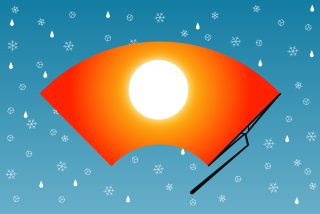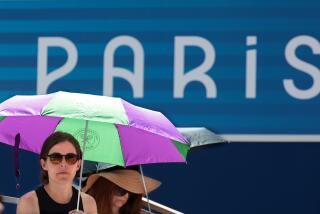Coaches’ Good Sense Is Best Strategy in Hot Weather
WALNUT — The thermometer on the side of the Mt. San Antonio College agricultural building registered nearly 90 degrees in the shade Saturday afternoon. The temperature came with a warning:
“Too Hot To Apply Herbicides And Fungicides.”
But not too hot to stop running?
That was the question of the day at the Mt. SAC Invitational, where the heat, dry wind and smog--along with the ever-brutal course--turned some of the meet’s 8,000 runners into staggering zombies.
It’s normal to finish this race looking haggard. In fact, it’s expected. No one worth his or her racing flats covers this three-mile hill fest without suffering. It’s a rite of passage, this Mt. SAC misery. You only have to run it once, but after you’ve finished, you’re one in a proud crowd.
But Saturday’s conditions were especially harsh, perhaps the worst in the meet’s 43-year history.
The sun was blazing by 10 a.m. The smog was so thick you’d think the gods had taken up chain smoking. And when the hot, dry wind kicked up in the early afternoon, the runners’ worst enemies--dehydration and heat exhaustion--pervaded the course, assaulting everyone in their path.
Before most runners even hit the first straightaway, some were already overheated.
You could see it in their faces--pale with one bright pink splotch on each cheek--as they made their way around the first mile mark. You could see it in their legs as they tried to power up Poop-Out Hill or the Switchbacks.
Nothin’ doing.
Runners, dizzy and sick, were carried from the finish line, carried off the course. Carried to the medical tents where they had to line up to lie down. Of course, many others managed the heat just fine. Some even tossed around a football, others, a Frisbee. Unfortunately, not all were feeling so playful.
A good part of distance running is dealing with pain, learning to push harder when you want to push less. But this was different.
Fortunately, there were no serious consequences.
By the time officials called off the meet--at 2:45 p.m., with only four races remaining--about 40 runners had been treated in the first-aid tent. Most of them got up and walked away under their own power. Six were hospitalized, but all were eventually released, even two whom paramedics diagnosed as having heat stroke, the most serious of heat-related illnesses.
The debate started as soon as the meet was called.
Should the races have been stopped sooner? Or not at all? Should officials consult weather reports next time and cancel the meet if such weather is predicted?
Or should everyone just stop whining, as part of cross-country is dealing with the elements?
David Stone, battalion chief of the Los Angeles County Fire Department, said meet officials should have been more prepared, should have had a full medical staff on hand instead of a handful of trainers.
Meet director Don Ruh said he has always relied on trainers--and nearby fire stations as his safety net. And besides, Ruh said, most of the runners felt just fine Saturday, “so let’s not blow it out of proportion.”
But let’s put it in perspective.
These were high school runners, many too inexperienced to know when to say when, and some, especially those from cooler beach areas, are not used to the hellish conditions here Saturday.
Someone has to be responsible for their immediate well-being, and with 8,000 entrants and an army of volunteers to oversee, that can’t always be Ruh or any other meet director, for that matter.
Coaches, are you listening?
Saturday, one coach actually scolded his runners for drinking water before their race. He told them they’d get cramps .
Is this the 1940s? Or was this (hopefully!) an isolated case of stupidity?
Being properly hydrated, especially on warm days, is perhaps the most important thing a runner can bring to the starting line. It’s as important as a helmet is to a football player. On days like Saturday, it can be life-and-death important.
But there wasn’t often a long line at the drinking fountain. Only a few runners walked around drinking from cups or squeeze bottles. And Ruh had a garden hose sprinkling throughout the day and most of the water puddled on the infield.
One coach, standing by as his heat-exhausted athlete was being loaded into the ambulance, said he had told her to drink water once during the day, but “What can you do? They’re kids.”
Exactly.


